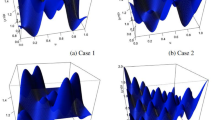Abstract
We consider the first-exit time of a compound Poisson process from a region that is bounded from below by an increasing straight line, while its upper boundary has positive jumps of i.i.d. sizes at Poisson times and increases linearly between jumps. An integral equation for the corresponding Laplace-Stieltjes transforms is derived and solved. The case of exponential jumps is treated separately. The problem has applications in queueing and risk theory.
Similar content being viewed by others
References
K. Borovkov and Z. Burq, “Kendall’s identity for the first crossing time revisited,” Electrical Communication Probability vol. 6 pp. 91–94, 2001.
R. J. Boucherie and O. J. Boxma, “The workload in the M/G/l queue with work removal,” Probability in the Engineering and Informational Sciences vol. 10 pp. 261–277, 1996.
J. DeLucia and H. Vincent Poor, “The moment-generating function of the stop-ping time for a linearly stopped Poisson process,” Stochastic Models vol. 13 pp. 272–292, 1997a.
J. DeLucia and H. Vincent Poor, “Performance analysis of sequential tests between Poisson processes,” IEEE Transactions on Information Theory vol. 43 pp. 221–238, 1997b.
S. F. L. Gallot, “Absorption and first-passage times for a compound Poisson process in a general upper boundary,” Journal of Applied Probability vol. 3 pp. 835–850, 1993.
H. Gerber, “Mathematical fun with ruin theory,” Insurance Mathematics and Economics vol. 7 pp. 15–23, 1988.
D. Perry, “Stopping problems for compound processes with applications to queues,” Journal of Statistical Planning and Inference vol. 91 pp. 65–75, 2000.
D. Perry, W. Stadje, and S. Zacks, “Busy period analysis for M/G/1 and G/M/1 type queues with restricted accessibility,” Operations Research Letters vol. 27 pp. 163–174, 2000.
D. Perry, W. Stadje, and S. Zacks, “First-exit times for compound Poisson processes for some types of positive and negative jumps,” Stochastic Models vol. 18 pp. 139–157, 2002b.
P. Picard and C. Lefèvre, “On the first crossing of the surplus process with a given upper barrier,” Insurance Mathematics and Economics vol. 4 pp. 163–179, 1994.
P. Picard, and C. Lefèvre, “First crossing of basic counting processes with lower non-linear boundaries: a unified approach through pseudopolynomials (I),” Advances in Applied Probability vol. 28 pp. 853–876, 1996.
P. Picard, and C. Lefèvre, “The probability of ruin in finite time with discrete claim size distribution,” Scandinavian Actuarial Journal pp. 58–69, 1997.
P. Picard and C. Lefèvre, “On the first meeting or crossing times of two independent trajectories for some counting processes,” Stochastic Processes and their Applications vol. 104 pp. 217–242, 2003.
W. Stadje, “Distribution of first-exit times for empirical counting and Poisson processes with moving boundaries,” Stochastic Models vol. 9 pp. 91–103, 1993.
W. Stadje and S. Zacks, “Upper first-exit times of compound Poisson processes revisited,” Probability in the Engineering and Informational Sciences vol. 17 pp. 459–465, 2003.
S. Zacks, “Distributions of stopping times for Poisson processes with linear boundaries,” Stochastic Models vol. 7 pp. 233–242, 1991.
S. Zacks, “Distributions of first exit times for Poisson processes with lower and upper linear boundaries,” In N. L. Johnson and N. Balakrishnan (eds.), A Volume in Honor of Samuel Kotz, Ch. 20, pp. 339–350, Wiley: New York, 1997.
S. Zacks, D. Perry, D. Bshouty, and S. Bar-Lev, “Distributions of stopping times for compound Poisson processes with positive jumps and linear boundaries,” Stochastic Models vol. 15 pp. 89–101, 1999.
Author information
Authors and Affiliations
Corresponding author
Additional information
AMS 2000 Mathematics Subject Classification: Primary 60G40; Secondary 62K25, 6OJ75
Rights and permissions
About this article
Cite this article
Perry, D., Stadje, W. & Zacks, S. A Two-Sided First-Exit Problem for a Compound Poisson Process with a Random Upper Boundary. Methodol Comput Appl Probab 7, 51–62 (2005). https://doi.org/10.1007/s11009-005-6654-6
Received:
Revised:
Accepted:
Issue Date:
DOI: https://doi.org/10.1007/s11009-005-6654-6




